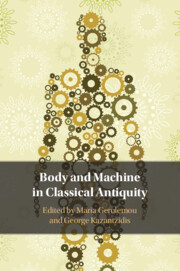Book contents
- Body and Machine in Classical Antiquity
- Body and Machine in Classical Antiquity
- Copyright page
- Contents
- Figures
- Contributors
- An Introduction to Body–Machine Intersections
- Part I Blended Bodies
- Part II The Technological Body
- Chapter 4 Technical Physicians and Medical Machines in the Hippocratic Corpus
- Chapter 5 The Empirical, Art and Science in Hippocrates’ On Joints
- Chapter 6 Hippocrates’ Diseases 4 and the Technological Body
- Part III Towards the Mechanization of the Human Body
- Index of Passages
- General Index
- References
Chapter 5 - The Empirical, Art and Science in Hippocrates’ On Joints
from Part II - The Technological Body
Published online by Cambridge University Press: 13 July 2023
- Body and Machine in Classical Antiquity
- Body and Machine in Classical Antiquity
- Copyright page
- Contents
- Figures
- Contributors
- An Introduction to Body–Machine Intersections
- Part I Blended Bodies
- Part II The Technological Body
- Chapter 4 Technical Physicians and Medical Machines in the Hippocratic Corpus
- Chapter 5 The Empirical, Art and Science in Hippocrates’ On Joints
- Chapter 6 Hippocrates’ Diseases 4 and the Technological Body
- Part III Towards the Mechanization of the Human Body
- Index of Passages
- General Index
- References
Summary
This chapter presents the several modes of reduction of the shoulder described by Hippocrates in On Joints 2–7 and evaluates them in relation to the phenomenon of leverage and the ancient tool, the lever (mochlos). It argues that Hippocrates’ understanding of leverage is a feature of his expertise as iētros and did not derive from any separate mechanical or scientific knowledge. This is especially interesting, since Hippocrates knew of the lever and some of its uses, but he describes techniques involving the reciprocal forces exerted between the patient’s dislocated bones and the physician’s own body. The chapter makes use of the analytic distinction between ostension and ostensive definition to characterize this expertise. It distinguishes among experience of physical forces, art that arises from such experience, and the physical principles of leverage that emerged a century or more later. There are references to On Fractures and On the Art.
- Type
- Chapter
- Information
- Body and Machine in Classical Antiquity , pp. 126 - 154Publisher: Cambridge University PressPrint publication year: 2023

